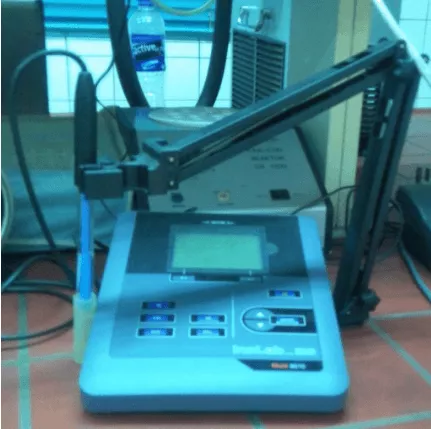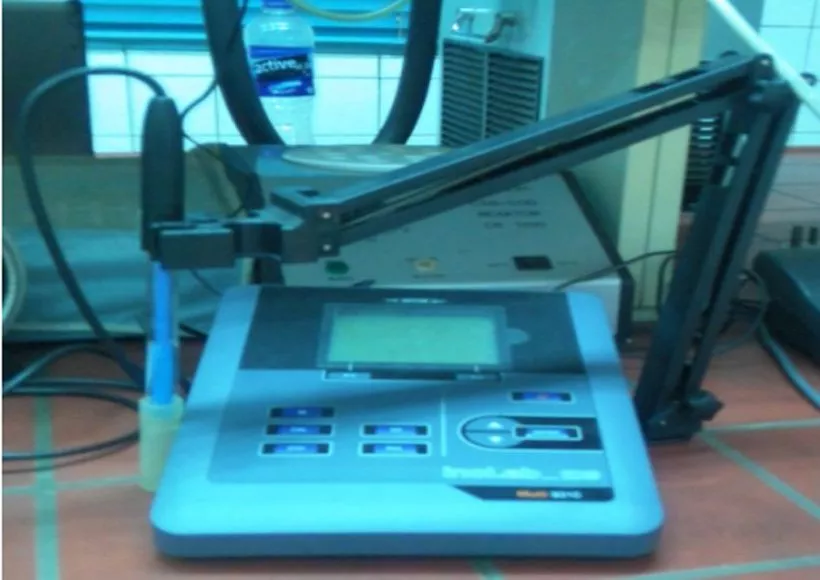Water analysis can be used to determine sample water suitability for several purposes, in such that it meets the requirements of medical, pharmacological, chemical, and industrial applications.
Generally, Chemical Industries, University or Research Institute Quality and Quantity Control Unit (Q&Q) carries out water analysis either on the field or in the laboratory using the following analytical equipment for Water Analysis:
- pH meter
- Spectrophotometer
- Mikroprozessor Photometer MPM 1500
- Lovibond AF355 Raw Water Kit
pH METER
The pH level of your drinking water reflects how acidic it is. pH means the potential of hydrogen referring to the amount of hydrogen found in a substance (in this case, water).
The pH scale is usually measured on a scale from 0 to 14. A pH scale that reads 7 means the substance is neutral, this means there is a balance between acid and alkalinity.
In addition, pH measurement below 7 means the substance is an acid and a measurement above 7 means the substance basic/alkaline.

Calibration of pH meter
- Pour Buffer solution 1 (4.0 pH) into a clean empty beaker
- Switch on the pH meter
- Rinse the pH meter probe with distilled water
- After that, Place the pH meter probe in the beaker containing the buffer solution 1
- pH meter will display the pH reading as 4.0
- Therefore, switch the buffer solution to Buffer solution 2 (7.0 pH)
- Again rinse the pH meter probe with distilled water
- Then place the pH meter probe in the beaker containing the buffer solution 2
- Now pH meter will show 7.0
In conclusion, we have calibrated the pH meter successfully!!!
Analyzing water sample using pH meter
- Pour the water sample into a clean beaker
- After that, rinse the pH meter probe with distilled water
- Place the pH meter probe in the beaker containing the water sample
- pH meter will show the pH reading of the water sample.
- Above all, note down the readings.
SPECTROPHOTOMETER
Generally, a spectrophotometer is used to carry out a calcium test, sulphate test, ammonium test, magnesium test, residual hardness test, iron test, lead test, chloride test, copper test, nitrate test.
CALCIUM CELL TEST (Ca)
Method [Water Analysis]
For instance, in neutral solution, calcium ions react with phthalein purple to form a violet dye that is determined photometrically.
Sample material
- Drinking water
- Groundwater and surface water
- Mineral water
- Nutrients solutions for fertilization
Procedure
- Pipette 1.0ml of the sample(20-300C) into a reaction cell, close the cell a mix
- Add 1.0ml of reagent Ca-1K with pipette and mix
- After that, leave to stand for exactly 3min
- Add 0.50ml of reagent Ca-2K with a pipette, close the cell, and mix
- In conclusion, Measure the sample in the photometer
SULFATE CELL TEST (SO42-)
Method
Generally, Sulfate ions react with barium ions from slight soluble barium sulfate. The slightly soluble substance has been the turbidity is measured in the photometer known as the turbidimetric method.
Sample material
- Drinking water
- Groundwater and surface water
- Wastewater
- Nutrients solutions for fertilization
Procedure
- Pipette 5.0m of the sample into a reaction cell and mix
- After that, add 1 micro spoon of reagent SO42-k, close the cell tightly and shakevigorously until the reagent is completely dissolved
- Leave to stand for exactly 2min
- In conclusion, measure the sample in the photometer
AMMONIUM (NH4+)
Method
Ammonium nitrogen (NH4-H) occurs partly in form of ammonium ions and partly as ammonia. A pH-dependent equilibrium exists between the two forms.
The strongly alkaline solution ammonium nitrogen is present almost entirely as ammonia, then reacts with hypochlorite ions to form monochloranime. Therefore, this in turn reacts with a substituted phenol to form a blue indophenol derivative that is determined photometrically.
Sample material
- Drinking water
- Groundwater and surface water
- Wastewater
- Nutrients solutions for fertilization
Procedure for Water Analysis
- Pipette 0.50ml of the sample into a reaction cell, close the cell, and mix
- After that, add 1 dose of reagent NH4-1K, close the cell tightly, and shake vigorously until the reagent is completely dissolved.
- Leave to stand for 15min, then measure the sample in the photometer.
MAGNESIUM CELL TEST (Mg)
Method
In neutral solution, magnesium ions react with phthalein purple to form a violet dye that is determined photometrically.
Sample material for water analysis
- Drinking water
- Groundwater and surface water
- Boiler water
- Nutrients solutions for fertilization
Procedure [Water Analysis]
- Pipette 1.0ml of the sample into a reaction cell, close the cell, and mix
- After that add 1.0ml of reagent Mg-1K with pipette and mix.
- Leave to stand for 3min.
- After that add 3 drops of reagent Mg-2K, close the cell, and mix
- In conclusion, measure the sample in the photometer.
RESIDUAL HARDNESS CELL TEST
The hardness (total hardness) of a given water is the amount of salts of the alkaline earth metals calcium, magnesium, strontium, and barium (hardening constituents) present in the water.
Since strontium and barium are generally present in waters only in traces, but the hardness is defined as amount of calcium ions, Ca2+, and magnesium ions, Mg2+ (hardness ions) present in the water.
The conventional procedure is to relate the statement of water hardness only to calcium, in other words to express also the content of magnesium ions as calcium content.
Hardness are generally measured pratically in English degree and German degree. I defined as follows:
10e = 14.25 mg/l CaCO3
10d = 10 mg/l CaO = 1.250e
Method
In alkaline solution calcium and magnesium ions react with phthalien purple to form a violet dye so that it is determined photometrically.
Sample material
- Check of ion-exchanger plants for the production of deionized water.
Procedure for Water Analysis
- Pipette 4.0ml of sample into a reaction cell, close the cell and mix.
- Add 0.20ml of reagent RH-1K with pipette, close the cell and mix.
- After that, Leave to stand for exactly 10min.
- Take the sample measurement in the photometer.
IRON TEST (Fe)
Method
All iron ions are reduced to iron(II) ions. In a thioglycolate-buffered medium, reaction occurs with a triazine derivative to form a red-violet complex that we can determined photometrically.
Sample material
- Drinking water
- Groundwater and surface water
- Wastewater and percolating water
- Industrial water
Procedure ( Water Analysis )
- Pipette 5.0ml of sample into a test tube.
- Add 3 drops of reagent Fe-1and mix
- After that, leave to stand for 3min, but then filled the sample into the cell and measure in the photometer.
LEAD CELL TEST (Pb)
Method
In alkaline solution lead(II) ions react with 4-(2’-pyridylazo) resorcinol (PAR) to form a red-violet complex so that it is determined photometrically.
Sample material for water analysis
- Drinking water and mineral water
- Groundwater and surface water
- Wastewater and percolating water
- Industrial water
- Sewage sludge
Procedure A: For the determination of lead in soft to medium hard waters with a Ca2+ content lower than 70mg/l.
- Place 5 drops of reagent Pb-1K into a reaction cell, close the cell tightly and mix.
- Pipette 5.0ml of sample, immediately close the cell tightly and mix.
- Measure the sample in the photometer: result A
Procedure B: For the determination of lead in hard to very hard waters with a Ca2+ content between 70 and 500mg/l.
- We use the same reaction cell, add 1 level grey microspoon of reagent Pb-2K into a reaction cell, close the cell tightly and shake until the reagent is completely dissolved.
- Measure the sample in the photometer: result B
- Lead content in mg/l = result A – result B
CHLORIDE TEST (Cl -) [Water Analysis]
Method
Chloride ions react with mercury(II) thiocyanate to form slightly dissociated mercury(II) chloride. The thiocyanate released in the process in turn reacts with iron(II) ions to form red iron(III) thiocyanate that we determined photometrically.
Sample material for water analysis
- Drinking water and mineral water
- Groundwater, surface water and seawater
- Wastewater and percolating water
- Industrial water
Procedure (Water Analysis)
Measuring range 2.5-25.0mg/l Cl-
- Pipette 5.0ml of sample into a test tube
- Add 2.5ml of reagent Cl-1 with pipette and mix.
- After that, add 0.5ml of reagent Cl-2 with pipette and mix
- Leave to stand for 1min, but then fill the sample into a 10-mm cell and therefore, measure in the photometer.
Measuring range 10-250mg/l Cl-
- Pipette 1.0ml of sample into a test tube
- Add 2.5ml of reagent Cl-1 with pipette and mix.
- After that, Add 0.5ml of reagent Cl-2 with pipette and mix
- Leave to stand for 1min, but then fill the sample into a 10-mm cell and measure in the photometer.
COPPER CELL TEST (Cu)
Method
In an ammoniacal medium copper(II) ions react with cuprizone to form a blue complex that we determined photometrically.
Sample material
- Drinking water and mineral water
- Groundwater, surface water and seawater
- Wastewater and percolating water
Procedure (Water Analysis)
- Pipette 5.0ml of sample into a reaction cell, close the cell and mix.
- Add 5 drops of reagent Cu-1K close the cell tightly and mix.
- Leave to stand for 5min, and then measure the sample in the photometer
NITRATE TEST (NO3-) [Water Analysis]
Method
In sulfuric and phosphoric solution nitrate ions react with 2,6-dimethylphenol (DMP) to form 4-nitro-2,6-dimethlyphenol so that it is determined photometrically.
Sample material
- Drinking water and mineral water
- Groundwater, surface water and drinking water
- Wastewater and industrial water
Procedure for Water Analysis
- Pipette 4.0ml of reagent NO3-1 into a dry test tube
- Add 0.5ml of sample with pipette, do not mix.
- After that, Add 0.5ml of reagent NO3-2with pipette and mix, holding only the upper part of the test tube (the mixture becomes hot)
- Leave the hot reaction to stand for 10min, do not cool with cold water.
- Fill the sample into the cell and measure in the photometer.

Pingback: Water Treatment and Water Quality Standard - Sampidia 4real